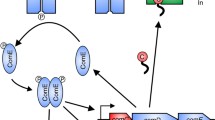Abstract
Quorum sensing (QS) is a process which allows a population of bacteria to coordinately regulate gene expression of their entire community. Bacillus subtilis is a soil organism which uses QS to alternate between competence for DNA uptake and sporulation. We propose a model to describe the components involved in QS and to analyze reaction species involved in the regulation of QS machinery. We targeted only those QS phenotypes for which the genetic organization and molecular characterization of the components are fully elucidated. We have analyzed simulations for concentration of different species involved in competence as well as sporulation pathways at diverse time period using quantitative methods. It was observed that there is possibility of achieving different measurement from reactions taken place between species by applying irreversible Michaelis–Menten kinetic law. We obtain variation in measurement on changing parameters such as concentrations ranging from 0.3 to 50 μM in stepwise manner by setting end time in the range of 0.1–100 ms. Additionally we observe covariance between different reaction species involved in QS by fluctuating their quantities in real-time simulations. Our model mimics correctly the phenotype for competence and virulence. We concluded that time factor play major role to determine rate kinetics of diverse reaction species as compared to their concentrations and support the hypothesis of getting genetic stability while colonies are in synchronization.





Similar content being viewed by others
References
Baca-DeLancey RR, South MMT, Ding X, Rather PN (1999) Escherichia coli genes regulated by cell-to-cell signaling. Proc Natl Acad Sci USA 96:4610–4614
Davies DG, Parsek MR, Pearson JP, Iglewski BH, Costerton JW, Greenberg EP (1998) The involvement of cell-to-cell signals in the development of bacterial biofilms. Science 280:295–298
Deep A, Chaudhary U, Gupta V (2011) Quorum sensing and bacterial pathogenicity: from molecules to disease. J Lab Phys 3:4–11
Dunny GM, Leonard BAB (1997) Cell-cell communication in Gram positive bacteria. Annu Rev Microbiol 51:527–564
Fujiya M, Musch MW, Nakagawa Y, Hu S, Alverdy J, Kohgo Y, Schneewind O, Jabri B, Chang EB (2007) The Bacillus subtilis quorum-sensing molecule CSF contributes to intestinal homeostasis via OCTN2, a host cell membrane transporter. Cell Host Microbe 1:299–308
Funahashi A, Tanimura N, Morohashi M, Kitano H (2003) Cell Designer: a process diagram editor for generegulatory and biochemical networks. BIOSILICO 1:159–162
Fuqua C, Winans SC, Greenberg EP (1996) Census and consensus in bacterial ecosystems: the LuxR-LuxI family of quorum-sensing transcriptional regulators. Annu Rev Microbiol 50:727–751
Hengge-Aronis R (1999) Interplay of global regulators and cell physiology in the general stress response of Escherichia coli. Curr Opin Microbiol 2:152–158
Ishihama A (1997) Adaptation of gene expression in stationary phase bacteria. Curr Opin Genet Dev 7:582–588
Kleerebezem M, Quadri LEN, Kuipers OP, de Vos WM (1997) Quorum sensing by peptide pheromones and two-component signal transduction systems in gram-positive bacteria. Mol Microbiol 24:895–904
Krasnogor N, Gheorghe M, Terrazas G, Diggle SP, Williams P, Camara M (2005) An appealing computational mechanism drawn from bacterial quorum sensing. Bull Eur Assoc Theor Comput Sci 85:135–148
Lazazzera BA (2000) Quorum sensing and starvation: signals for entry into stationary phase. Curr Opin Microbiol 3:177–182
Li S, Brazhnik P, Sobral B, Tyson JJ (2008) A quantitative study of division cycle of Caulobacter crescentus stalked cell. PLoS Comput Biol 4(1):e9
Machné R, Finney A, Müller S, Lu J, Widder S, Flamm C (2006) The SBML ODE solver library: a native API for symbolic and fast numerical analysis of reaction networks. Bioinformatics 22(11):1406–1407
Mader U, Schmeisky AG, Florez LA, Stulke J (2012) SubtiWiki-a comprehensive community resource for the model organism Bacillus subtilis. Nucleic Acids Res (Database issue) 40:D1278–D1287
Melke P, Sahlin P, Levchenko A, Johnsson H (2010) A cell-based model for quorum sensing in heterogeneous bacterial colonies. PLoS Comput Biol 6:e1000819
Panigrahi PP, Singh TR (2012) Computational analysis for functional and evolutionary aspects of BACE-1 and associated Alzheimer’s related proteins. Int J Comp Intel Stud 1:322–332
Rumbaugh KP, Diggle SP, Watters CM, Ross-Gillespie A, Griffin AS, West SA (2007) Quorum sensing and the social evolution of bacterial virulence. Curr Biol 19:341–345
Schauder S, Bassler BL (2012) The language of bacteria. Genes Dev 15:1468–1480
Solomon JM, Grossman AD (1996) Who’s competent and when: regulation of natural genetic competence in bacteria. Trends Genet 12:150–155
Steggles LJ, Banks R, Shaw O, Wipat A (2007) Qualitatively modelling and analysing genetic regulatory networks: a Petri net approach. Bioinformatics 23:336–343
Stephenson K, Lewis RJ (2005) Molecular insights into the initiation of sporulation in gram-positive bacteria: new technologies for an old phenomenon. FEMS Microbiol Rev 29:281–301
Stragier P, Losick R (1996) Molecular genetics of sporulation in Bacillus subtilis. Annu Rev Genet 30:297–341
Ulas T, Riemer SA, Zaparty M, Siebers B, Schomburg D (2012) Genome-scale reconstruction and analysis of the metabolic network in the hyperthermophilic archaeon sulfolobus solfataricus. PLoS One 7:e43401
Williams P, Winzer K, Chan W, Camara M (2007) Look who’s talking: communication and quorum sensing in the bacterial world. Phil Trans R Soc B 362:1119–1134
Wuster A, Madan Babu M (2008) Conservation and evolutionary dynamics of the agr cell-to-cell communication system across firmicutes. J Bacteriol 190(2):743–746
Acknowledgments
A.K. acknowledges the financial support of Jaypee University of Information Technology (JUIT) as M. Tech. fellowship.
Author information
Authors and Affiliations
Corresponding author
Rights and permissions
About this article
Cite this article
Kumar, A., Singh, T.R. A quantitative study of gene regulatory pathways in Bacillus subtilis for virulence and competence phenotype by quorum sensing. Syst Synth Biol 7, 33–39 (2013). https://doi.org/10.1007/s11693-013-9105-7
Received:
Revised:
Accepted:
Published:
Issue Date:
DOI: https://doi.org/10.1007/s11693-013-9105-7




